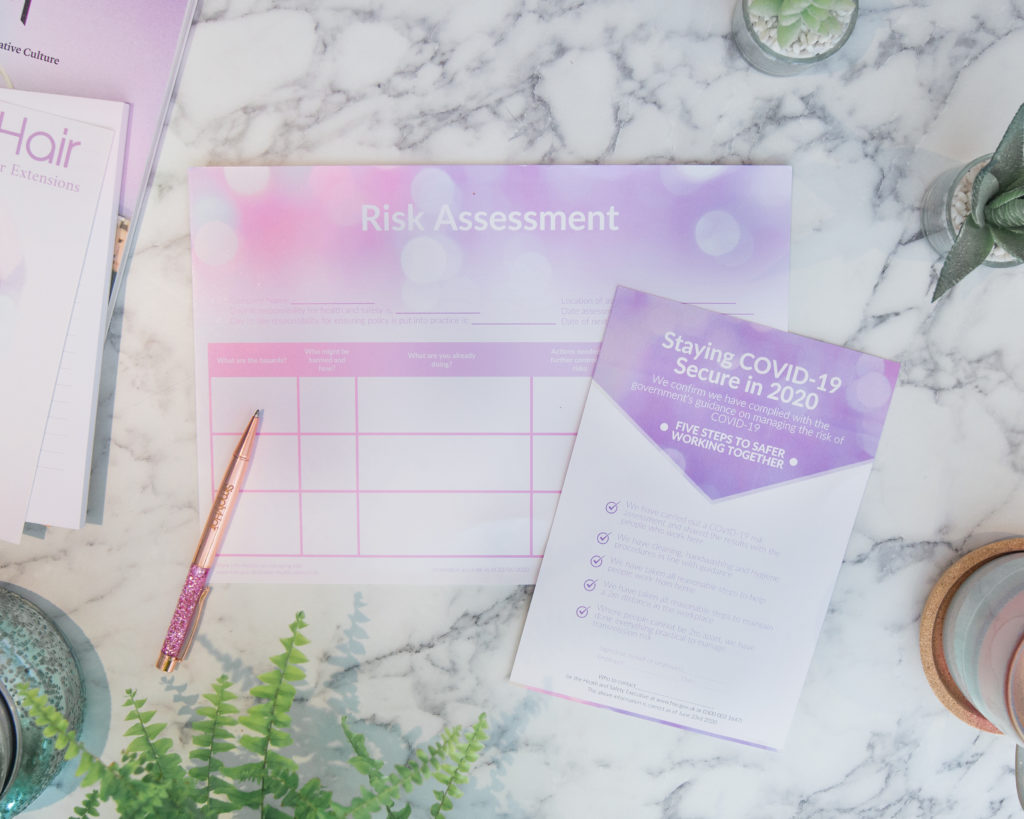Risk Assessment For Hair Extensionists and Salons (COVID-19)
Risk assessments are vital as part of any business, regardless of whether you work alone or have multiple employees. With COVID-19 now added to the mix, performing a thorough risk assessment before opening back up for business is incredibly important, and something to be taken seriously.
As an employer, you have a legal obligation to protect workers and others from risk to their health and safety, and a risk assessment allows you to focus on each element of the business, encouraging you to think about the environment you are working in, and ways in which you can improve it.

Risk Assessments For Hair Extensionists
If you have fewer than five employees or are self-employed, you still need to perform a risk assessment, but you do not need to write anything down. Having said that, it is still good practice to do so, and we have provided you with a template in order to do this effectively. Your risk assessment will help you identify that you have done everything you need to in order to have a safe working environment.
Failure to complete a risk assessment which takes account of COVID-19, or failing to put measures into place that manage the risk of COVID-19, could constitute a breach of health safety law, so it is very important that you perform your risk assessments.
Who can do a risk assessment?
Any competent person in your business can perform a risk assessment, and as a mobile hair extensionist, this will most likely be the business owner. If you do have others working for you they can do the risk assessment on your behalf, however, it is best to appoint someone with the best well-rounded knowledge and experience.
First Step - Identify Hazards
You need to look around your workplace, be that your salon, home salon or customer home, and think with a “worst-case scenario” mentality. What could cause harm to either you or a customer? It is best to think about:
- How people work and how they use equipment
- Are there any chemicals or hazardous materials used?
- Is your workplace tidy?
- What equipment are customers likely to come into contact with?
Unlike risk assessments you would have completed before, you will also need to think of hazards in terms of virus protection, so you would be looking at things such as:
- What needs regular cleaning?
- Where are your “high traffic areas”?
- What would you do if you identified an area that has potentially been contaminated?
Think about hazards from both the employee perspective and the customer perspective, as these will be different.


Risk Assessments For Mobile Hair Extensionists
Whilst we have not been able to identify any specific risk assessment guidelines for those working in clients homes, it would be best practise to perform a risk assessment before you start working. When you arrive at your client’s home, take the extra 10 minutes to perform a quick risk assessment of the room you will be working in, in order to identify any hazards and to act upon them promptly.
Vulnerable Workers
You may have individuals in your business who are particularly vulnerable, for example; those with disabilities, expectant mothers or immunocompromised, so it is important to take these individual factors into consideration for both standard risk assessment hazards and Covid-19 hazards.
Involve Your Employees in your Risk Assessments
Often managers and business owners are no longer working in customer-facing roles, or on the salon floor, therefore if this is the case in your business, it is an excellent idea to hold a meeting to discuss potential risks. Employees will most likely come up with many ideas that you perhaps did not think of, and will ensure you have a really thorough risk assessment in place.
Assess the Risks Identified in your Hair Extension Business.
Once you have identified all of the potential hazards in your workplace, you can assess how likely it is that a member of staff or the public will be harmed by this risk, and how serious a risk it is. In order to determine the risk level you should be thinking about:
- Who might be harmed and how?
- What steps you already have in place to reduce the risk?
- What additional steps you could put in place?
- Who is responsible for putting the extra steps in place?
- When do you expect this to be completed by?
- Can I eliminate the risk altogether?
- How can I make harm unlikely?
Of course, you aren't expected to eliminate all risks, as this is not realistic, however you are expected to have identified and tried to find solutions, to demonstrate you are aware of any potential risks.
Recording Your Findings
If you have fewer than five employees or are self-employed, you do not need to write anything down as part of your risk assessment, however if you employ five or more people, you must record your significant findings, taking note of:
- What the hazards are?
- Who is likely to be affected by these hazards?
- What steps you have in place to control, prevent or eliminate a hazard?
Review Your Risk Assessment Regularly
It is best to review your risk assessment regularly, as things change quickly in work environments.
Sharing the Results of your Risk Assessment
If you have employees, your workforce should be able to see your risk assessment, and it is best practice to consider posting on your website for easy access (all businesses with more than 50 employees are required to do so).
You should sign and display a notice to demonstrate you have performed a risk assessment, and that your premises is COVID-19 secure, and this should be put in a prominent place in your business and on your website if you have one.


































